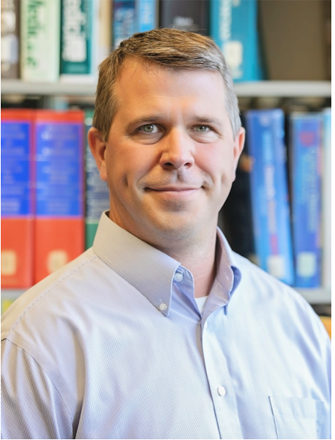Main Content Area
Physiology Faculty

Life Science III Rm 2053C
Email: pjensik@siumed.edu
- PHSL 490 Senior Seminar
- PHSL 410A/511A Mammalian Physiology (Renal)
- Medical Physiology Resource Sessions in Cardiovascular, Respiratory, and Renal (CRR) unit
- PHSL 500 - Advanced Seminar in Physiology
- Medical School Year One Problem Based Learning Tutor (CRR unit)
Neurodevelopmental disorders including autism spectrum disorders (ASD) and intellectual disabilities affect approximately 12% of children in the United States. Mutations in specific genes can cause intellectual disabilities and have also been linked to ASD. Our laboratory studies the transcription factor deformed epidermal autoregulatory factor 1 (DEAF1). Heritable and de novo mutations in the DEAF1 gene cause intellectual disabilities and a high percentage of these individuals also have ASD.
Using of a combination of genetically modified mice and molecular and cellular approaches we are determining the mechanisms by which mutant DEAF1 proteins cause intellectual disabilities.
For more information on individuals with mutations in the DEAF1 gene please visit:
http://humandiseasegenes.nl/deaf1/
McGee SR, Rose GM, Jensik PJ. Impaired memory and marble burying activity in deformed epidermal autoregulatory factor 1 (Deaf1) conditional knockout mice. Behav Brain Res. 2020 Feb 17;380:112383. doi: 10.1016/j.bbr.2019.112383. Epub 2019 Nov 26.
Maria J. Nabais Sá1, Philip J. Jensik1, Stacey R. McGee, Michael J. Parker, Farah Kanani, Nayana Lahiri, Evan P. McNeil, Hester Y. Kroes, Randi J. Hagerman, Rachel E. Harrison, Tara Montgomery, Miranda Splitt, Elizabeth E. Palmer, Rani K. Sachdev, Heather C. Mefford, Abbey A. Scott, Julian A. Martinez-Agosto, Rüdiger Lorenz, Naama Ornstein, Jessica R. Litwin, Jonathan N. Berg, Jeanne Amiel, Delphine Heron, Boris Keren, Jan-Maarten Cobben, Leonie Menke, Elysa J. Marco, Tyler Mark Pierson, John Graham, Ehsan Ghayoor Karimiani, Reza Maroofian, Chiara Manzini, Roberto Colombo, Sylvie Odent, Christele Dubourg, Chanika Phornphutkul, Arjan P.M. de Brouwer, Bert B. A. de Vries, Anneke T. Vulto-vanSilfhout. De novo and biallelic DEAF1 variants cause a phenotypic spectrum. Genetics in Medicine 2019 Mar.
Chen L, Jensik P, Alaimo J, Walkiewicz M, Berger S, Roeder E, Faqeih E, Bernstein J, Smith A, Mullegama S, Saffen D, Elsea S. Functional analysis of novel DEAF1 variants identified through clinical exome sequencing expands DEAF1-associated neurodevelopmental disorder (DAND) phenotype. Hum Mutat. 2017 Dec;38(12):1774-1785
Mullegama S, Jensik P, Li C, Dorrani N; UCLA Clinical Genomics Center, Kantarci S, Blumberg B, Grody W, Strom S. Coupling clinical exome sequencing with functional characterization studies to diagnose a patient with familial Mediterranean fever and MED13L haploinsufficiency syndromes. Clin Case Rep. 2017 Apr 18;5(6):833-840
Jensik P, Arbogast L. Regulation of Cytokine Inducible SH2 Domain protein (CIS) by Ubiquitination and Elongin B/C interactions. Mol Cell Endocrinol. 2015 Feb 5; 401: 130-41.
Jensik P1, Vargas J1, Rajamanickam S, Reardon S, Huggenvik J, Collard M. DEAF1 Binds Unmethylated and Flexibly Spaced CpG Dinucleotide Motifs. PloS One. 2014 Dec 22; 9(12): e115908. 1Co-First Authors.
Vulto-van Silfhout AT1, Rajamanickam S1, Jensik P1, Vergult S, de Rocker N, Newhall KJ, Raghavan R, Reardon SN, Jarrett K, McIntyre T, Bulinski J, Ownby SL, Huggenvik JI, McKnight GS, Rose GM, Cai X, Willaert A, Zweier C, Endele S, de Ligt J, van Bon BW, Lugtenberg D, de Vries PF, Veltman JA, van Bokhoven H, Brunner HG, Rauch A, de Brouwer AP, Carvill GL, Hoischen A, Mefford HC, Eichler EE, Vissers LE, Menten B, Collard MW, de Vries BB. Mutations affecting the SAND domain of DEAF1 cause intellectual disability with severe speech impairment and behavioral problems. Am J Hum Genet. 2014 May 1; 94(5):649- 61. 1Co-First Authors.
Fujimaki-Aoba K, Tanaka K, Inomata R, Jensik P, and Takada M. a-ENaC in bullfrog embryo: expression in cement gland, gills, and skin. Cell Tissue Research. Cell Tissue Res. 2014 Jan; 355(1): 103-9.
Fujimaki-Aoba K, Komazaki S, Jensik P, Hokari S, and Takada M. Larval bullfrog skin lacks amiloride-blockable epithelial transport because a-ENaC are within intracellular vesicles, not in apical plasma membrane, in epidermal apical cells. Acta Histochem. 2013 May; 115(4): 357- 362.
Jensik P, Huggenvik J, Collard M. Deformed Epidermal Autoregulatory Factor-1 (DEAF1) Interacts with the Ku70 Subunit of the DNA-Dependent Protein Kinase Complex. Plos One. 2012 March;7(3):e33404.
Jensik P, Arbogast L. Differential and interactive effects of ligand-bound progesterone receptor A and B isoforms on tyrosine hydroxylase promoter activity. J Neuroendocrinol. 2011 Oct;23(10):915-25.
Takada M, Shimomura T, Hokari S, Jensik P, Cox T. Larval bullfrog skin expresses ENaC despite having no amiloride-blockable transepithelial Na(+) transport. J Comp Physiol [B]. 2006 May;176(4):287-93.
Jensik P, Huggenvik J, Collard M. Identification of a nuclear export signal and protein interaction domains in deformed epidermal autoregulatory factor-1 (DEAF-1). J Biol Chem. 2004 Jul 30;279(31):32692-9.
Jensik P, Holbird D, Cox T. Cloned bullfrog skin sodium (fENaC) and xENaC subunits hybridize to form functional sodium channels. J Comp Physiol [B]. 2002 Oct;172(7):569-76.
Jensik P, Cox T. ATP-induced internalization of amphibian epithelial P2X receptors is linked to channel opening. Pflugers Arch. 2002 Sep;444(6):795-800.
Jensik P, Holbird D, Collard M, Cox T. Cloning and characterization of a functional P2X receptor from larval bullfrog skin. Am J Physiol Cell Physiol. 2001 Sep;281(3):C954-62.
Holbird D, Jensik P, Cox T. Aldosterone upregulates purinergic responses in larval amphibian skin epithelium. J Comp Physiol [B]. 2001 Jun;171(5):413-20.
